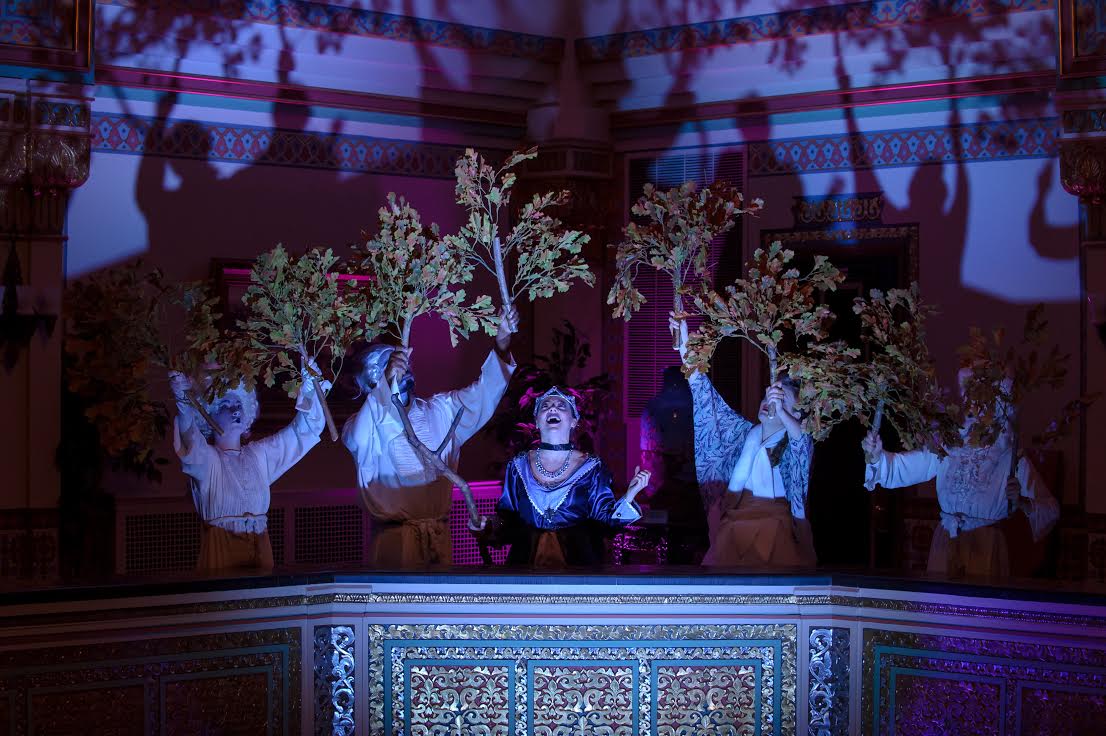
by Jeff Grygny
In Herman Hesse’s counterculture favorite Steppenwolf, the suicidal protagonist stumbles on “The Magic Theater,” a hypnogogic mystery rite that transforms the soul through despair to wisdom. On his way he encounters Mozart, one of the Immortals, whose music embodies both the crystalline structure and divine playfulness of the cosmos. Mozart, of course, penned The Magic Flute (along with his less-immortal collaborator Emanuel Schikaneder) as a fantasy on themes of the Masonic order to which they both belonged; such secret societies were key players in the political and philosophical upheavals of the day—arguably the United States was itself founded on the principles of Reason, Wisdom, and Brotherhood that the Masons espoused.
This is only by way of background to the amazingly coincidental appearance of Zie Magic Flute, a stripped-down and upgraded version of the classic opera now in performance by Milwaukee Opera Theatre at a time when at least half the nation is contemplating the noose. As if auditioning for the role of The Magic Theatre, this goofy, warm-hearted production is a fine antidote for politically-triggered despond. Produced in collaboration with Quasimondo Physical Theatre and Cadance Collective, it’s a creative dream team, each group dedicated to artistic cross-fertilization and rattling the cages of tradition. Together, they go completely outside the lines of what might be the closest thing Mozart ever made to a coloring book. What’s more, they play in what may be the single most brilliant venue for this opera in the city: the grandly arabesque Tripoli Shrine Center, home of the heirs of the very order Mozart celebrated. There, under a fantastic domed vault, among ornate gilded columns, stands a grand piano, around which the entire piece plays: music is the literal center of the show. Music director Paula Foley Tillen plays barefoot and fearlessly, while Flutist Emma Koi and Cellist Alicia Storin sometimes leave their seats to join in the action swirling all around.
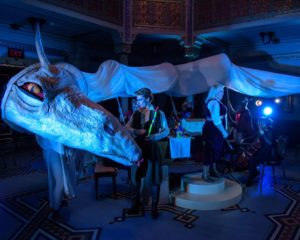
Co-directors Jill Anna Ponasik and Brian Rott seem intent on creating a world of joyful play, where problems are easily resolved and love and wisdom conquer, all in the key of Loony Tunes (it’s probably one of the few Mozart productions that features a kazoo in the orchestration). But then, the story of The Magic Flute is silly even by operatic standards; the characters are paper-thin, the plot makes little sense, and the initiation ordeals of Tamino and Papageno would seem puerile to a fraternity. It’s story as music; or music masquerading in the costume of narrative. Schikaneder’s libretto has been loosely rendered into contemporary rhyme by Daniel J. Brylow, who sets the irreverent mood by including puns, colloquialisms, and even internet slang; at one point the Queen of the Night’s ladies (comically clad as Wagnerian valkyries) serenade Tamino with a chorus of “TTYL.” There was plenty of appreciative tittering from the opening night audience, but since the staging is in the round, there’s a one in four chance someone will be facing away from you, unfortunately rendering some of Brylow’s witty lyrics unclear. The directors’ decision to leave some of the songs in the original German doesn’t noticeably trouble the narrative flow; it just adds a little Teutonic flavor to the mix.
Quasimondo’s Brian Rott brings his characteristic sense of incongruity to the staging, which delightfully encompasses the balcony that circles the playing space, on which appear riders on horseback, rhythmically trembling tree branches, and a large white dragon. The three helpful spirits, dressed as periwigged aristocrats, wield twirling streamers, plastic birds, and fuzzy puppets to people the show with various creatures. It’s a minimalist strategy that feels surprisingly rich, especially combined with Nikki Maritch’s humorous costumes and lit by electrical wizard Jason Fassl in heraldic hues that turn the Moorish architecture into a glittering jewel box.
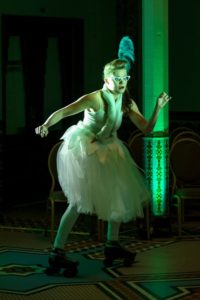
This abbreviated version expunges many of the original’s 18th-century tropes that the 21st century finds unacceptable: gone are Sarastro’s conniving blackamoor slave and his injunctions never to trust women. Indeed, this show is far from heteronormative, including a girl-on-girl pas de deux during the climactic hymn to love. As Tamino, the charismatic Benjamin Ludwig seems not at all the stereotypical hero: he tempers his ringing tenor with boyish anxiety, and shares the stage generously with his collaborators. Jennifer Hansen and Christal Wagner as Pamima and Papagena display anything but retiring femininity; Wagner, in cat’s-eye glasses and a dress that echoes Bjork’s famous swan costume, skates around the stage like a roller derby queen, while Hansen adds muscularity to her sweet portrayal of the heroine.
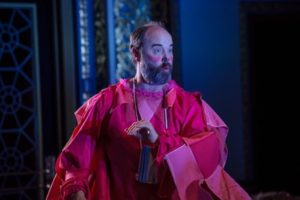
As the weird bird-man Papageno, Nathan Wesselowski acquits himself admirably with vocal and comic grace, while Sarah Richardson’s Queen of the Night more than compensates in musicianship what she may lack in stature; her bravura rendition of “Der Hölle Rache,” which won rapturous applause, still gives us time to ponder the paradox that one of the loveliest arias in music is actually an exhortation to murder. Not to worry though; in a wave of mythopoeic revisionism, the Queen is forgiven, not banished. Director Ponasik has given high priest Sarastro a speaking rather than a singing role—which pays off, as we can listen to Mark Corkins majestically intone the lyrics, his solemn delivery somewhat softened by the Shriner’s fez he sports. The twinkle in his eyes makes it all work somehow.
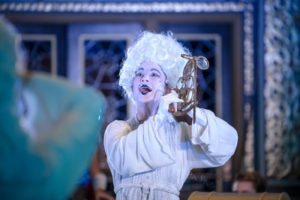
The show gains immeasurably from Quasimondo’s spirit-cum-stagehands. Jenni Reinke, Jessi Miller, and Andrew Parchman mostly play in pantomime, though they sometimes sing admirably well alongside the schooled musicians of Milwaukee Opera Theatre and Cadance Collective. As white-clad baroque clowns, they summon whatever miracles the action demands. Miller’s expressions are wonderfully off-beat as she commits herself to the narrative machinations; Reinke whips the serpent’s tail with fine fury; and Parchman’s puppet hippopotamus is as fully-realized a character as any in the show.
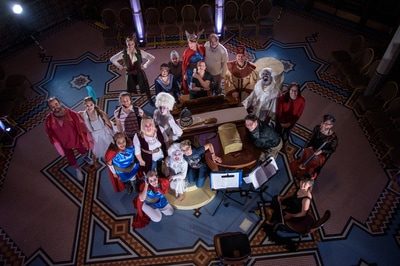
However lighthearted, Mozart’s vision in The Magic Flute is of a world governed by wisdom and love, overseen by initiates who had faced their weaknesses to become worthy stewards of an enlightened society. Near the end of Steppenwolf, Mozart tells the protagonist “Learn what is to be taken seriously and laugh at the rest.” Not the easiest advice to follow—but it might help keep your head out of the oven for the next four years.
Milwaukee Opera Theatre
in collaboration with Quasimondo Physical Theatre
and Cadance Collective
present
Zie Magic Flute
Music by W. A. Mozart
Libretto by Emanuel Schikaneder
English Translation by Daniel J. Brylow
Directed by Jill Anna Ponasik & Brian Rott
Playing:
Wednesday, January 25 at 7:30 PM,
Friday, January 27 at 7:30 PM,
Saturday, January 28 at 1:00 PM,
Sunday, January 29 at 1:00 PM
Tripoli Shrine Center
3000 W. Wisconsin Avenue, Milwaukee
TICKETS
$28 General Admission
$18 Student & Artist
Order Online or call 1-800-838-3006
“The Tripoli Shrine Center offers ample free parking adjacent to the venue.”

I don’t know, Jeff — my head may go into the oven anyway. But your review is wonderful.